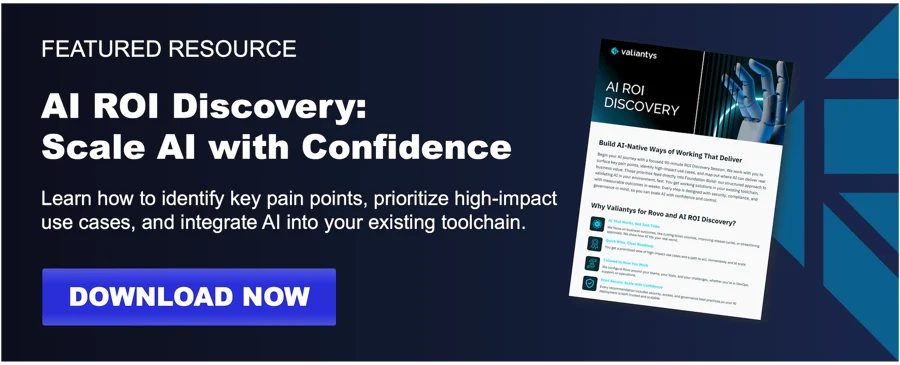AI promises transformative potential, but far too many organizations stumble at the starting line. At Valiantys, we’ve helped clients navigate this terrain through structured discovery, rapid validation, and scalable delivery. Across industries, common mistakes continue to block progress. Avoiding them is the first step toward turning AI from buzzword to business value.
1. Confusing the Tool with the Outcome
Many teams dive into AI without first understanding what kind of AI they’re dealing with or what they’re trying to achieve.
- ML (Machine Learning) finds patterns in data. Think: forecasting churn or tagging support tickets.
- GenAI (Generative AI)/LLMs (Large Language Models) creates content, images, stories, and even code.
- Agentic AI combines GenAI with goals, memory, and tools. These agents can execute complex tasks, like triaging tickets or onboarding new hires, autonomously.
Failing to differentiate between these capabilities leads to wasted effort. ML models won’t write documentation. A chatbot isn’t going to resolve SLA incidents on its own.
Best Practice: Anchor the conversation in business needs first, then map the right AI capability to the job. During our ROI Discovery sessions, we work with clients to isolate the most valuable friction points, and only then match them to AI solutions whether that’s a search-optimized LLM, a compliance agent, or a workflow accelerator.
2. Prioritizing Governance Before Value
Governance is essential, but governance without a working use case is academic. Too many organizations stall because they attempt to build an enterprise-wide AI policy before proving AI can deliver value.
This often leads to:
- Abstract policies disconnected from real workflows
- Delay in adoption due to compliance bottlenecks
- Overengineered control mechanisms that stifle experimentation
Better Path: Start with a high-potential, low-risk use case. Show it works. Then scale governance with your learnings.
At Valiantys, every AI Foundation Build includes embedded governance and security practices—not as a barrier to entry, but as a backbone for scale. This balance of agility and responsibility enables our clients to move fast and stay compliant.
3. Thinking Too Small
Perhaps the most limiting mistake: failing to connect AI to strategic impact. Leaders often frame AI initiatives around incremental automation, optimizing a form, summarizing a doc, or generating a meeting note while missing the bigger opportunity.
AI isn’t just about saving minutes. It’s about rethinking how work gets done:
- Replacing manual onboarding with digital assistants
- Reducing incident response time from hours to seconds
- Turning tribal knowledge into reusable, scalable workflows
Lesson: If you don’t aim for transformation, you’ll settle for tools. And tools alone don’t deliver ROI.
That’s why our AI-native transformation program is built as a value ladder, starting with small wins but always pointing toward bigger goals like shifting from human-heavy delivery models to service-as-a-software engagements.
4. Ignoring Cultural Readiness and Change Management
Even the most powerful AI will stall without buy-in from the people it’s meant to help. Cultural resistance is the hidden tax on every AI initiative. When AI is rolled out without context, training, or co-creation, it gets blocked, bypassed, or blamed.
Symptoms include:
- Employees revert to manual workarounds.
- Employees won’t make time to test the new system
- AI outputs are mistrusted or misunderstood.
- Rollouts are seen as “experiments” rather than business-critical initiatives.
Better Path:
Change enablement must be embedded from day one. We work with clients to:
- Communicate clearly what AI is (and isn’t).
- Identify champions and skeptics early.
- Equip teams with the fluency to use AI meaningfully.
AI success isn’t just technical, it’s behavioral. We make sure your people are ready to scale what works.
5. Misunderstanding What Data You Actually Need
There’s a widespread myth that you need massive, clean datasets before you can do anything useful with AI. That’s true for Machine Learning (ML)—but not for Large Language Models (LLMs).
ML requires historical data to identify patterns: things like ticket volumes, time-to-resolution, or churn trends. These models need training, tuning, and lots of structured input to be effective.
LLMs are different.
They come pre-trained on billions of data points. You don’t have to “train” them—you guide them. Even with limited internal data, you can get high-impact results by connecting LLMs to existing documentation, workflows, or tools.
We help clients:
- Connect LLMs to knowledge bases to reduce time-to-answer.
- Add guardrails for accuracy and governance.
- Use retrieval-augmented generation (RAG) to keep AI grounded in their reality.
Better Path:
Start with what you have. Most organizations already have more usable content than they think—Confluence pages, onboarding guides, runbooks... With the right structure, that’s all an LLM needs to begin delivering value. Rovo enables you to specify what content it is allowed to use, consider it best practice to start today and curate context over time.
The bottom line:
You don’t need big data to get started. You need the right data, in the right shape. And we’ll help you get there.
Final Word: Start Now, Start Right
For most organizations, the biggest risk isn’t bad AI, it’s no AI. Whether the obstacle is unclear strategy, internal resistance, or lack of clarity, the solution is the same: start with real use cases, solve real problems, bring people on board and build credibility with outcomes.
If you’re ready to explore what AI can actually do in your environment, don’t start with a vendor pitch. Start with a focused, tailored conversation about your work and where AI can help.
That’s what our AI ROI Discovery is designed for: structured, outcome-oriented entry into AI that builds alignment, momentum, and value in weeks not quarters.
Contact us or check out our AI ROI Discovery Guide today!





